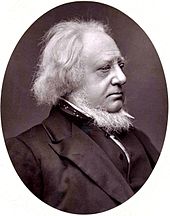Henry Cole

Sir Henry Cole
Biography

Henry Cole was born in
The record office was constituted in 1838 under the Public Record Office Act 1838, and Cole became one of the four senior assistant-keepers. He ranged a large mass of records in the Carlton House Riding School, where he was placed for the purpose 2 November 1841. His reports upon the unsuitability of this place contributed to bring about the erection of the building in Fetter Lane (begun in 1851). Cole's duties at the record office did not absorb his whole energy. In 1838, with the leave of his superiors, he became secretary to a committee for promoting postal reform. He edited their organ, the Post Circular, suggested by himself, of which the first number appeared 14 March 1838. He got up petitions and meetings with such energy that Cobden offered to him in 1839 the secretaryship of the Anti-Cornlaw League. Parliament granted power to carry out the new postal scheme in August 1839, and the treasury offered premiums for the best proposals as to stamps. Cole gained one of the premiums; he attended the treasury to discuss details, and was employed there till the beginning of 1842 in working out the scheme.
From 1837 to 1840, he worked as an assistant to
In 1843, Cole introduced the world's first commercial Christmas card,[4] commissioning artist John Callcott Horsley to make the artwork.[5]
Felix Summerly pseudonym
Cole was personally interested in industrial design, and under the pseudonym Felix Summerly designed a number of items which went into production, including a prize-winning
Cole and the exhibitions
Through his membership of the
Cole visited the 1849 11th Quinquennial Paris Exhibition and noticed the lack of an exhibition open to international participants. He saw that the RSA's planned exhibitions for 1850 and 1851 could be adapted into a larger international exhibition, and he secured the backing of Queen Victoria to establish in 1850 the Royal Commission for the Exhibition of 1851 to manage the new exhibition, under the Presidency of Prince Albert.
The Great Exhibition of the Works of Industry of all Nations was held in the Crystal Palace in Hyde Park, London, from 1 May to 15 October 1851, and was an enormous popular and financial success, partially due to the astute management of Henry Cole.
Museums
As one of the Commissioners, Cole was instrumental in the decision that the £186,000 surplus from the Great Exhibition would be used for improving science and art education in the United Kingdom. Land was purchased in the South Kensington area and developed as the centre for a number of educational and cultural institutions, known half-jokingly as "
Honours and legacy
Cole was instrumental in the development of the National Art Training School (renamed the
Cole was awarded the
An English heritage blue plaque commemorates where Cole lived and worked at 33 Thurloe Square, South Kensington, London, opposite the Victoria and Albert Museum.[9]
In 2001, one of Cole's first Christmas cards, which was sent to his grandmother in 1843, sold at
References
- ^ a b Christmas card sold for record price BBC News. Retrieved 12 June 2011
- ^ "Vanity Fair cartoon of Sir Henry Cole". chmuseum.org.uk. Retrieved 9 October 2017.
- ^ "World's First Christmas Card". British Postal Museum and Archive. Archived from the original on 22 March 2014. Retrieved 1 September 2013.
- ^ György Buday, George Buday (1992). The history of the Christmas card. p.8. Omnigraphics, 1992
- ^ Earnshaw, Iris (November 2003). "The History of Christmas Cards". Inverloch Historical Society Inc. Retrieved 25 July 2008.
- ^ "Albertopolis: Henry Cole Wing". Royal Institute of British Architects. Archived from the original on 28 September 2012. Retrieved 16 December 2010.
- ^ Adolf K. Placzek (1982) Macmillan encyclopedia of architects, Volume 1, p. 437, Free Press, 1982
- ^ Hobhouse, Hermione (1983), Prince Albert, his life and work, p. 91, H. Hamilton
- ^ Blue plaque of Sir Henry Cole English heritage Retrieved 17 December 2010
- ^ Facts And Figures – GCA: The Greeting Card Association Retrieved 12 June 2011
- Attribution
![]() This article incorporates text from a publication now in the public domain: "Cole, Henry". Dictionary of National Biography. London: Smith, Elder & Co. 1885–1900.
This article incorporates text from a publication now in the public domain: "Cole, Henry". Dictionary of National Biography. London: Smith, Elder & Co. 1885–1900.
Further reading
- Bonython, Elizabeth and Anthony BurtonThe Great Exhibitor: The Life and Work of Henry Cole, London: V & A, 2003.
- Bonython, Elizabeth King Cole: A Picture Portrait of Sir Henry Cole, London, 1985.
- Cole, Henry Fifty years of public work of Sir Henry Cole accounted for in his deeds, speeches and writings, (in two volumes) London, Bell and Sons, 1884 (Completed by Henrietta and Alan S. Cole after Henry Cole's death).
- Design Council Archive – University of Brighton Design Archives (Journal of Design and Manufactures)
- Journal of Design and Manufactures
External links
 Media related to Henry Cole at Wikimedia Commons
Media related to Henry Cole at Wikimedia Commons Works by or about Henry Cole at Wikisource
Works by or about Henry Cole at Wikisource- Works by Henry Cole at Project Gutenberg
- Works by or about Henry Cole at Internet Archive
- "Archival material relating to Henry Cole". UK National Archives.
- Sir Henry Cole and the first Christmas Card
- Obituary of Sir Henry Cole The Times, 20 April 1882, from the Victoria and Albert Museum
